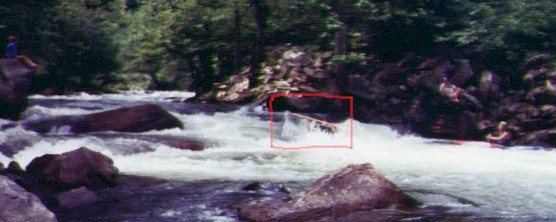
Today's lesson is on rafting and kayaking. Specifically, we are going to
discuss the rapid known as Nantahala Falls, found on the Nantahala River (of course)
in southwestern North Carolina. Here is image #1.
The red box is drawn to help you locate the raft which is currently traversing
the second and larger drop sideways. Lesson #1 is: do not go
over drops sideways. Notice the serious lack of people
still in the raft. This is proof that lesson #1 is valid.
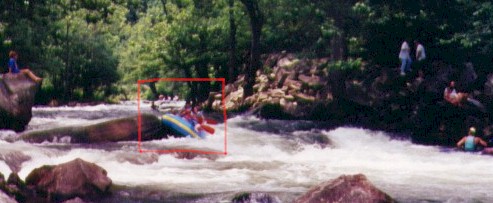
Here we have image #2. You'll notice that we've closed in on the large rock which
lies river right as you enter the rapid. (River left in this picture).
Lesson #2 is: do not hit the large rock at the entrance to the rapid.
Naturally, this picture shows a raft full of people who have failed to
miss the large rock. Soon, this will be a raft that isn't full of
people.
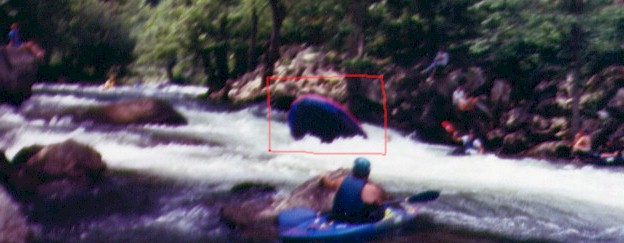
For image #3 we focus on the second drop once again. Here at the bottom of the
drop (in the helpful red box) is what we call a hole. This really
isn't particularly dangerous to people in a raft, unless you have absolutely
no forward speed whatsoever. (Which is nearly impossible unless,
of course, you've lost your paddle in the entrance to the rapid).
Lesson #3 is: Do not lose your paddle before entering the rapid.
This raft has become caught (momentarily) in the hole, and is attempting
the advanced kayaking move known as an ender. However, this doesn't
work well in a raft because there's nothing to really hold you in.
This results in swimming.
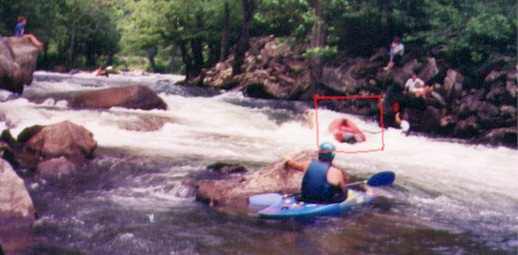
Now you may be wondering, what would happen if I allowed my paddle to become
caught in the current, and since I was trying to follow lesson #3, I didn't
let go, so I followed it right over the edge of my raft and into the river.
The answer is: you'd become wet, probably cold, and you'd get to
swim the remainder of the rapid. Lesson #4 is: Do not swim through
the rapid when you have a perfectly good boat. Here in image
#4 is a perfectly good boat. You'll notice the people who had crewed
this boat have failed to follow lesson #4. Shame on them.
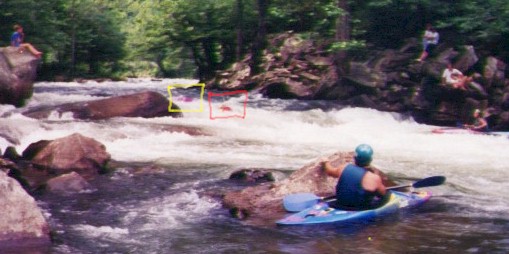
Some of you may be wondering if the above rules apply to kayaks as well.
Lesson #5 is: Lessons #1 through #4 apply to kayaks as well. Here
we have two kayaks (we've called in the reserve yellow box to help our
viewers at home as well). Now you'll notice that they have and most
likely will avoid hitting the big rock. However, they have failed
to stay in their boats, and there's really no way of telling what they
might have done with their paddles. This is wrong.
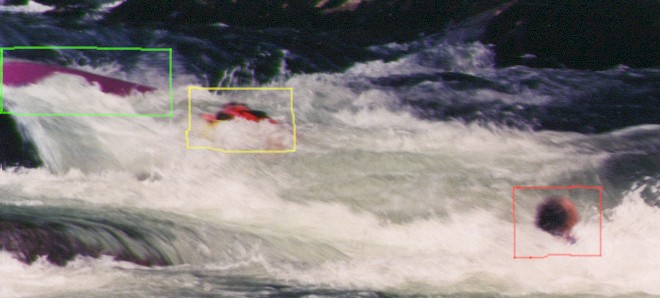
At this point you're no doubt thinking: Wow! Look at all the boxes.
Here we see, surrounded by the now-familiar red box, a person.
Our less familiar yellow box is pointing out the personal flotation device
or, if you prefer, the lifejacket. And the newly hired green box
is indicating the boat. The more astute reader will have already
pounced on the fact that lesson #4 is going woefully unheeded at this point.
Furthermore, lesson #6 is also being violated. Lesson #6 is:
Do not go swimming without your lifejacket.
By the way, we should mention that none of the people on this web page were
harmed (physically) in the making of this web page.
 Today's lesson is on rafting and kayaking. Specifically, we are going to
discuss the rapid known as Nantahala Falls, found on the Nantahala River (of course)
in southwestern North Carolina. Here is image #1.
The red box is drawn to help you locate the raft which is currently traversing
the second and larger drop sideways. Lesson #1 is: do not go
over drops sideways. Notice the serious lack of people
still in the raft. This is proof that lesson #1 is valid.
Today's lesson is on rafting and kayaking. Specifically, we are going to
discuss the rapid known as Nantahala Falls, found on the Nantahala River (of course)
in southwestern North Carolina. Here is image #1.
The red box is drawn to help you locate the raft which is currently traversing
the second and larger drop sideways. Lesson #1 is: do not go
over drops sideways. Notice the serious lack of people
still in the raft. This is proof that lesson #1 is valid.  Today's lesson is on rafting and kayaking. Specifically, we are going to
discuss the rapid known as Nantahala Falls, found on the Nantahala River (of course)
in southwestern North Carolina. Here is image #1.
The red box is drawn to help you locate the raft which is currently traversing
the second and larger drop sideways. Lesson #1 is: do not go
over drops sideways. Notice the serious lack of people
still in the raft. This is proof that lesson #1 is valid.
Today's lesson is on rafting and kayaking. Specifically, we are going to
discuss the rapid known as Nantahala Falls, found on the Nantahala River (of course)
in southwestern North Carolina. Here is image #1.
The red box is drawn to help you locate the raft which is currently traversing
the second and larger drop sideways. Lesson #1 is: do not go
over drops sideways. Notice the serious lack of people
still in the raft. This is proof that lesson #1 is valid.  Here we have image #2. You'll notice that we've closed in on the large rock which
lies river right as you enter the rapid. (River left in this picture).
Lesson #2 is: do not hit the large rock at the entrance to the rapid.
Naturally, this picture shows a raft full of people who have failed to
miss the large rock. Soon, this will be a raft that isn't full of
people.
Here we have image #2. You'll notice that we've closed in on the large rock which
lies river right as you enter the rapid. (River left in this picture).
Lesson #2 is: do not hit the large rock at the entrance to the rapid.
Naturally, this picture shows a raft full of people who have failed to
miss the large rock. Soon, this will be a raft that isn't full of
people.
 For image #3 we focus on the second drop once again. Here at the bottom of the
drop (in the helpful red box) is what we call a hole. This really
isn't particularly dangerous to people in a raft, unless you have absolutely
no forward speed whatsoever. (Which is nearly impossible unless,
of course, you've lost your paddle in the entrance to the rapid).
Lesson #3 is: Do not lose your paddle before entering the rapid.
This raft has become caught (momentarily) in the hole, and is attempting
the advanced kayaking move known as an ender. However, this doesn't
work well in a raft because there's nothing to really hold you in.
This results in swimming.
For image #3 we focus on the second drop once again. Here at the bottom of the
drop (in the helpful red box) is what we call a hole. This really
isn't particularly dangerous to people in a raft, unless you have absolutely
no forward speed whatsoever. (Which is nearly impossible unless,
of course, you've lost your paddle in the entrance to the rapid).
Lesson #3 is: Do not lose your paddle before entering the rapid.
This raft has become caught (momentarily) in the hole, and is attempting
the advanced kayaking move known as an ender. However, this doesn't
work well in a raft because there's nothing to really hold you in.
This results in swimming.
 Now you may be wondering, what would happen if I allowed my paddle to become
caught in the current, and since I was trying to follow lesson #3, I didn't
let go, so I followed it right over the edge of my raft and into the river.
The answer is: you'd become wet, probably cold, and you'd get to
swim the remainder of the rapid. Lesson #4 is: Do not swim through
the rapid when you have a perfectly good boat. Here in image
#4 is a perfectly good boat. You'll notice the people who had crewed
this boat have failed to follow lesson #4. Shame on them.
Now you may be wondering, what would happen if I allowed my paddle to become
caught in the current, and since I was trying to follow lesson #3, I didn't
let go, so I followed it right over the edge of my raft and into the river.
The answer is: you'd become wet, probably cold, and you'd get to
swim the remainder of the rapid. Lesson #4 is: Do not swim through
the rapid when you have a perfectly good boat. Here in image
#4 is a perfectly good boat. You'll notice the people who had crewed
this boat have failed to follow lesson #4. Shame on them.  Some of you may be wondering if the above rules apply to kayaks as well.
Lesson #5 is: Lessons #1 through #4 apply to kayaks as well. Here
we have two kayaks (we've called in the reserve yellow box to help our
viewers at home as well). Now you'll notice that they have and most
likely will avoid hitting the big rock. However, they have failed
to stay in their boats, and there's really no way of telling what they
might have done with their paddles. This is wrong.
Some of you may be wondering if the above rules apply to kayaks as well.
Lesson #5 is: Lessons #1 through #4 apply to kayaks as well. Here
we have two kayaks (we've called in the reserve yellow box to help our
viewers at home as well). Now you'll notice that they have and most
likely will avoid hitting the big rock. However, they have failed
to stay in their boats, and there's really no way of telling what they
might have done with their paddles. This is wrong.
 At this point you're no doubt thinking: Wow! Look at all the boxes.
Here we see, surrounded by the now-familiar red box, a person.
Our less familiar yellow box is pointing out the personal flotation device
or, if you prefer, the lifejacket. And the newly hired green box
is indicating the boat. The more astute reader will have already
pounced on the fact that lesson #4 is going woefully unheeded at this point.
Furthermore, lesson #6 is also being violated. Lesson #6 is:
Do not go swimming without your lifejacket.
By the way, we should mention that none of the people on this web page were
harmed (physically) in the making of this web page.
At this point you're no doubt thinking: Wow! Look at all the boxes.
Here we see, surrounded by the now-familiar red box, a person.
Our less familiar yellow box is pointing out the personal flotation device
or, if you prefer, the lifejacket. And the newly hired green box
is indicating the boat. The more astute reader will have already
pounced on the fact that lesson #4 is going woefully unheeded at this point.
Furthermore, lesson #6 is also being violated. Lesson #6 is:
Do not go swimming without your lifejacket.
By the way, we should mention that none of the people on this web page were
harmed (physically) in the making of this web page.